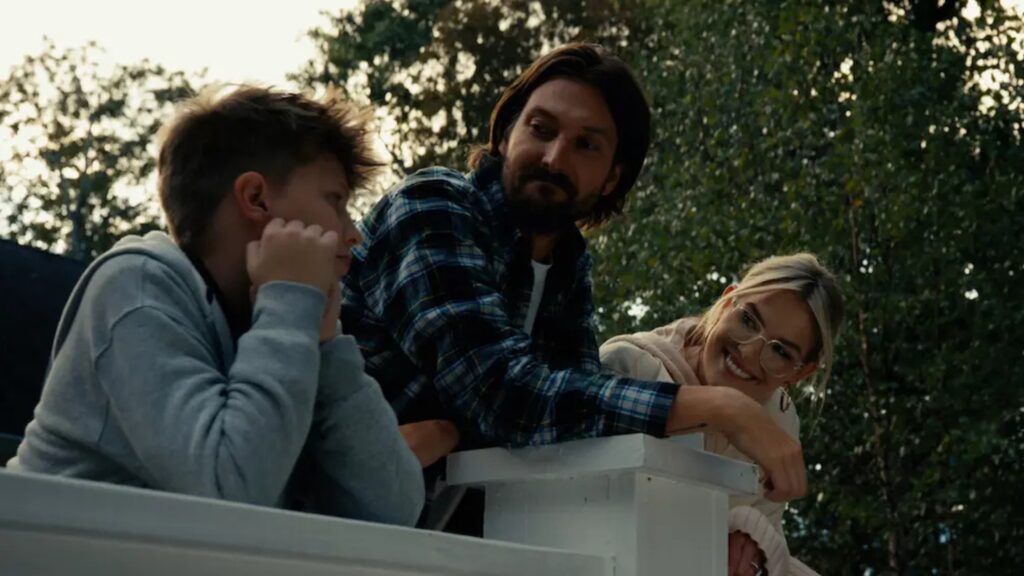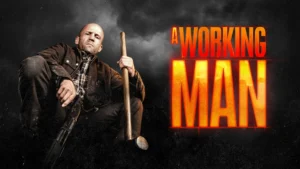The Wildman of Shaggy Creek — small-town summer magic, Bigfoot, and a kid who has to grow up fast.
The Wildman of Shaggy Creek is a family-friendly coming-of-age adventure that leans into summertime wonder and a touch of rural folklore: a boy, a rumored “wildman” in the woods (think Bigfoot-lite), and the kinds of dares and discoveries that turn an ordinary neighborhood into the setting of a story you’ll tell for years. It played the limited-release / festival circuit in 2025 and — for what it sets out to be — it mostly delivers what families will want: heart, mild scares, and a scouting-trip feel. Below you’ll find who’s in it, who the movie is about, how it performed, what niche it fills, and a deep look at the film (plot, themes, strengths and weaknesses).
Quick facts (need-to-know).
Title / Year: The Wildman of Shaggy Creek (2025).
Director: Jesse Edwards.
Tone / Genre: Family adventure / coming-of-age with light monster-lore (Bigfoot) beats.
Release: Limited U.S. theatrical release — August 1, 2025 (select theaters / family-event distributor).
Runtime: ~76–80 minutes (family-friendly, brisk).
Cast — how many, who are the principals.
This is a small ensemble built around a core group of kids and a few adults — the kind of cast that keeps a family adventure focused and intimate. Counting the principal child actors and the credited adult supporting players, the film features roughly 10–15 named performers with meaningful screen time.
The top names credited across industry listings are:
- Hudson Hensley as Scott (the story’s young lead).
- Allee-Sutton Hethcoat as Charlotte (friend / co-conspirator).
- Josh Futcher as Charlie (another member of the friend group).
- Ayla Bullington as Hailey.
- A handful of other child actors — Brycen Patterson, Pierson Mashburn, Ella Kaminski — plus a few adult bit players who play parents, local officials, and the occasional skeptical neighbor.
Because the film is squarely a children’s adventure, the story privileges the kid cast; the adults are present mostly as texture and gentle obstacles rather than central dramatic engines. The result is the classic “kids-on-a-mission” dynamic that powers everything from 1980s G-rated adventures to contemporary family fare.
Who is the “means character” — who drives the story?
The narrative centers on Scott (Hudson Hensley). The plot is told from his point of view: he’s the kid who hears the rumor about a Wildman living in the woods behind his house, accepts a dare or two, and slowly realizes that the thing everyone shrugs off as campfire lore might be more real — and far more complicated — than expected. The film is Scott’s test: fear versus curiosity, childish bravado versus real courage. The other kids orbit him, but Scott’s come-of-age choices are the emotional engine.
Box-office / commercial performance — what the numbers say.
The Wildman of Shaggy Creek was released as a limited theatrical family event rather than a wide studio roll-out, so its grosses are modest by blockbuster standards. Industry box-office trackers show that in its initial week the film opened in a very small number of theaters (dozens at most) and returned modest day-by-day totals typical for family-event releases. One industry snapshot shows weekend grosses in the low thousands in the handful of theaters playing it — exactly what you’d expect for a targeted limited run distributed by a niche family-event company. (These runs are often paired with home-rental / VOD windows soon after.).
What that means in practice: this movie wasn’t aiming for mass box-office domination; it was designed to be a modest, cozy, local-theater experience and an eventual family-viewing title on streaming or video-on-demand. Judged by those terms, it achieves its commercial aim: enough theatrical footprint to build word-of-mouth and then move into the home-video pipeline where it can find its audience.
The niche — who will like this movie?
The Wildman of Shaggy Creek sits squarely in the family adventure / kid’s summer movie niche. More specifically, it’s for viewers who enjoy:
- kid-led mystery/adventure (a la The Goonies or Stand by Me, but gentler),
- light monster lore (Bigfoot/“wildman” as wonder rather than full horror), and
- stories about friendship, courage, and backyard-scale heroism.
It’s the kind of film parents take their kids to for an early evening outing — mildly spooky, always reassuring, and focused on emotional lessons rather than shocks. If you like movies where children confront a folklore creature and come out braver and wiser, this one is for you.

Deep dive — plot, themes, craft, and what works.
The setup — dares, rumors, and the pull of the woods
The film opens in a tidy small town. Scott is the kind of kid you recognize instantly: curious, brave enough to bite off more than he can chew, and impatient for some story to make his summer feel important. When stories circulate about a shaggy “wildman” living in the creek-cut woods behind the houses — broken crops, strange footprints, and odd nighttime noises — Scott and his friends decide to investigate. Think flashlights, rope, walkie-talkies, and the kind of honest arguing that knits small groups of kids into alliances.
That initial simplicity is the film’s strength: it doesn’t try to be more than a child’s summer mythic quest, and by keeping the viewpoint tightly on the kids the filmmakers preserve a sense of wonder. The Wildman is treated with just enough ambiguity to let the audience oscillate between fear and sympathy — a choice that keeps the emotional stakes accessible to younger viewers while offering older kids and adults a slightly deeper subtext.
The middle — clues, compassion, and a gradual reframe
As the kids inch closer to the truth, the movie complicates the “monster” label. The Wildman’s signifiers (large footprints, ramshackle hiding places) are there, but so are signs that he’s not a mindless threat: food taken from empty porches in a neat way, shy tracks from a lumbering creature that seems to avoid people unless provoked. The children — especially Scott and Charlotte — begin to ask whether the Wildman is a thing to be feared or a being to be understood.
Here the movie leans into the best family-film instincts. There are scenes of gentle reconnaissance, missed encounters that turn into quiet exchanges, and an adult subplot (a sympathetic local ranger or an older neighbor) who suggests patience rather than panic. The story becomes as much about empathy — “don’t panic; try to see” — as about capturing a legendary creature.
The emotional stakes — courage, guilt, and growing up
A hallmark of the film is how it uses the Wildman myth to surface ordinary kid dilemmas. One friend is the daring type who wants glory; another is anxious about disappointing his parents. Scott’s journey is internal as much as external: he learns to pause before acting, to consider consequences, and to stand up for what’s right even when his peers egg him on toward spectacle. The Wildman functions as a mirror for those lessons: confronting the “monster” forces the kids to confront their own worst impulses.
There are also small moral complications the movie handles nicely. The kids must decide whether to keep the “discovery” secret to protect the creature, or to tell the adults to be safe — a classic children’s-adventure dilemma. The film doesn’t hand out easy answers; it favors the children making a brave but responsible choice that shows real growth.
The climax — tension without terror
Family pictures like this succeed when the climax delivers tension while remaining age-appropriate. The Wildman of Shaggy Creek stages its pivotal moments in the woods at dusk: a near encounter, a dangerous fall, and a final moment where Scott must choose between bravado and compassion. The action is handled with simple staging and practical effects (a costumed performer, some atmospheric lighting, and quick cutting), and the filmmakers make adult viewers do the work of sensing threat even as kids experience wonder. The payoff is emotionally pleasing: discovery tempered by acceptance, and the Wildman ultimately revealed as more lonely than murderous.
Visuals, sound, and the film’s economy
Because this is a small family feature, production values are modest but serviceable. The cinematography favors warm, late-afternoon light to make the woods look magical rather than menacing; close framing keeps the camera at kid-height, which helps the audience see the world from the children’s scale. The score is light and adventurous, focusing on simple motifs rather than sweeping themes — the right choice for a movie that wants intimacy over spectacle.
Strengths — what the movie does well.
Kid-first perspective. Keeping the story from Scott’s view preserves wonder and shields young viewers from anything too bleak.
Heart over horror. The film chooses empathy rather than terror, which makes it a safer family option for those wary of scarier monster fare.
Short runtime & brisk pacing. At around 76 minutes it doesn’t overstay its welcome — ideal for younger attention spans and repeat family watches.
An ensemble of likeable child actors. The young cast sells camaraderie and believable childhood argument.
Weaknesses — where it could be stronger
Light on adult characters. The adults mostly exist to nudge or worry; viewers seeking layered grown-up subplots may find the film thin.
Predictable beats. The structure follows well-worn family adventure templates; if you’ve seen similar films, surprises are limited.
Modest production scale. Practical effects are earnest but not cinematic-epic; audiences expecting a high-end creature feature will be disappointed.
Final verdict — who should see it?
The Wildman of Shaggy Creek is a warm, small-scale family movie that will work best for parents with younger school-age kids who want a gentle adventure with a moral heart. It’s not trying to haunt or to rework the monster movie into something new — it’s content to take folklore and make it an instrument for teaching compassion and courage. If you want a modest, earnest summertime family outing — and you don’t mind low budget creature effects — this one will do the job.
If you’re chasing big VFX spectacle, deep adult themes, or a radical reinvention of Bigfoot lore, look elsewhere. But if your priority is a kid-centered story about friendship and learning to be brave in small but meaningful ways, The Wildman of Shaggy Creek is a pleasant, honest watch.





